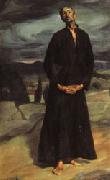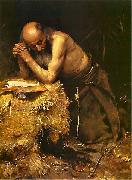Wholesale Oil Painting No Minimum |
|||||||||||
|
|
|||||||||||

|
|||||||||||
|
|
|
||||||||
Ignacio ZuloagaSpanish Painter, 1870-1945 was a Spanish Basque painter, born in Eibar, in the Basque country, near the monastery of Loyola. He was the son of metalworker and damascener Placido Zuloaga and grandson of the organizer and director of the royal armoury in Madrid. In his youth, he drew and worked in his father's workshop. He was educated by the Jesuits in France. His father wanted him to be an architect, and with this objective in mind, he was sent to Rome, where he immediately followed the strong impulse that led him to painting. After only six months' work he completed his first picture, which was exhibited at the Paris Salon of 1890. Continuing his studies in Paris, where he lived for five years, he was strongly influenced by Paul Gauguin and Henri de Toulouse-Lautrec. Only upon returning to his native land did he find his true style, which is based on the national Spanish tradition embodied in the work of Diego Velazquez, Francisco de Zurbaran, El Greco, and Francisco Goya. Bleeding Christ; or Blood Christ (El cristo de la Sangre) (1911)His own country was slow in acknowledging the young artist whose strong, decorative and rugged style stood in opposition to the styles of well-known modern Spanish artists such as Fortuny, Madrazo, |
||||||||
|
|
||||||||
The Anchorite
The Anchorite Painting ID:: 11859 |
1907
6' 2'' x 3' 9 1/4''(188 x 115 cm)Bequest of Paul Cosson,1926 1907 6' 2'' x 3' 9 1/4''(188 x 115 cm)Bequest of Paul Cosson,1926 |
|||||||
|
|
||||||||
Teodor Axentowiczborn May 13, 1859 in Braşov, Romania - August 26, 1938 in Krakew) was a Polish-Armenian painter and university professor. A renowned artist of his times, he was also the rector of the Academy of Fine Arts in Krakew. As an artist, Axentowicz was famous for his portraits and subtle scenes of Hutsul life, set in the Carpathians. Axentowicz was born May 13, 1859 in Braşov, Hungary (now Romania), to a family of Polish-Armenian ancestry. In 1893 in Chelsea, London, he married Iza Henrietta Gielgud, aunt of Val Gielgud and John [Arthur] Gielgud of the theatrical dynasty. A son, Philip S.A.D. Axentowicz was born in Chelsea in 1893. Between 1879 and 1882 he studied at the Academy of Fine Arts in Munich. From there he moved to Paris, where he continued his education until 1895. During that time he started a long-time cooperation with various journals and started his career as a copyist, duplicating the works of Tizian and Botticelli. He also made numerous travels to London and Rome, where he prepared a set of portraits, one of the first in his career. |
||||||||
|
|
||||||||
|
|
The Anchorite
The Anchorite Painting ID:: 91381 |
1881(1881)
Medium oil on canvas
Dimensions 129 x 95 cm (50.8 x 37.4 in)
cyf 1881(1881) Medium oil on canvas Dimensions 129 x 95 cm (50.8 x 37.4 in) cyf |
||||||
|
|
||||||||
|
Teodor Axentowicz born May 13, 1859 in Braşov, Romania - August 26, 1938 in Krakew) was a Polish-Armenian painter and university professor. A renowned artist of his times, he was also the rector of the Academy of Fine Arts in Krakew. As an artist, Axentowicz was famous for his portraits and subtle scenes of Hutsul life, set in the Carpathians. Axentowicz was born May 13, 1859 in Braşov, Hungary (now Romania), to a family of Polish-Armenian ancestry. In 1893 in Chelsea, London, he married Iza Henrietta Gielgud, aunt of Val Gielgud and John [Arthur] Gielgud of the theatrical dynasty. A son, Philip S.A.D. Axentowicz was born in Chelsea in 1893. Between 1879 and 1882 he studied at the Academy of Fine Arts in Munich. From there he moved to Paris, where he continued his education until 1895. During that time he started a long-time cooperation with various journals and started his career as a copyist, duplicating the works of Tizian and Botticelli. He also made numerous travels to London and Rome, where he prepared a set of portraits, one of the first in his career. The Anchorite 1881(1881) Medium oil on canvas Dimensions 129 x 95 cm (50.8 x 37.4 in) cyf |
||||||||
|
|
||||||||
|
Prev Next
|
||||||||
|
|
||||||||
|
Related Paintings to Teodor Axentowicz :. |
||||||||
|
|
||||||||
|
CONTACT US |


